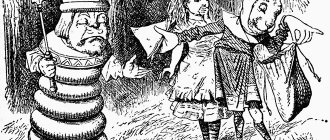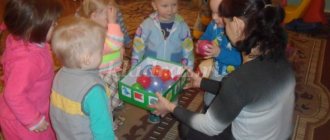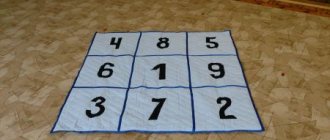Card index of games for 6-7 years old
The movement of the carousel gradually slows down. At the words “The game is over,” the children lower the cord to the ground and disperse around the playground. After the children have rested a little, the teacher gives a signal (bell, whistle, clapping, hitting a tambourine), according to which the players again stand in a circle, take hold of the cord, i.e., take their places on the carousel. The game is resumed and repeated 3-4 times.
Directions.
The teacher can instruct the children to quickly stand in a circle using conventional signals when repeating the game. A player who does not have time to take a seat before the third signal does not take part in the next ride on the carousel, but waits for the next boarding.
TRAPPING IN A CIRCLE
Goal: Develop the ability to operate in a limited space; agility and speed
A circle is drawn on the ground, the diameter of which is 3-5 m. Using a counting rhyme, the players choose a trap. He stands in the center of the circle, the rest of the children are behind the circle. After the teacher’s words: “One, two, three - catch it!” the children run across the circle, and the trap catches them. You can only fish in a circle. When a certain number of children are caught, a new trap is chosen.
WHERE DID IVANUSHKA BATH?
At this time, the teacher touches all the children one by one with folded palms and quietly lowers a pebble to one of them.
At the end of the text, all palms should be closed. Ivanushka turns to the players and tries to guess who has the pebble.
If he guesses right, he sits in the place of the child who had the pebble, and he becomes Ivanushka. If he doesn’t guess correctly, he leads again. Without guessing the next time, he sits down on the end of the bench, and Ivanushka gets out again.
When children have mastered the game well, they organize it themselves, choosing the leader and Ivanushka using a counting rhyme.
TRAP, GET THE TAPE!
Goal: Develop dexterity.
The players stand in a circle. Each of them has a colored ribbon that is placed behind the belt or collar. There is a trap in the center of the circle. At the teacher’s signal “run,” the children scatter around the playground. The trap runs after the players, trying to take a ribbon from one of them. The one who has lost his ribbon temporarily moves aside. To the teacher’s words “One, two, three - quickly run into the circle!” children line up in a circle. The catcher counts the number of ribbons taken and returns them to the children. The game continues with a new trap.
Directions.
The same trap can be cast 2-3 times. The game task becomes more complicated by reducing the length of the ribbon.
DON'T GET YOUR FEET WET
Goal: Develop balance. Learn to act in concert.
The players gather on one side of the court behind the line. The teacher calls 5-6 children, they go to the line, each receives 2 boards (30 X 20 cm). On the opposite side of the site, plumes are laid out on the same line. Between the players and the benefits there is a swamp. Children must cross the swamp on planks without getting their feet wet (stepping only on the planks). At the teacher’s command “Begin!” the players put one board and stand on it, then move to another board, take the one from behind to put it in front of them again, etc. Having crossed the swamp, the children collect the boards, take the plumes and raise them above their heads. It is noted who raised the plume first. Then the children put the sultanas back, return to their places and pass the planks to the next ones.
Card index of didactic games for preschool children (5-7 years old)
Explanatory note
Cognitive and intellectual play is one of the effective forms that makes it possible to make interesting and exciting not only the work of preschoolers at the creative and exploratory level, but also the study or consolidation of the material covered, which is carried out within the framework of the program.
The purpose of educational games
: increasing the level of intellectual and creative abilities of children of senior preschool age through a system of educational games.
Tasks:
to form mental actions in preschoolers with the help of educational games: analysis, synthesis, generalization, classification, abstraction;
create conditions for the development of children’s intellectual and creative abilities, taking into account their age and individual characteristics;
develop the ability to think and plan one’s actions, make decisions in accordance with given rules, and check the results of one’s actions;
strengthen interest in games that require mental stress, intellectual effort, the desire and need to learn new things.
A game
- This is a natural form of learning for a preschooler.
This is part of his cumulative life experience. When transferring knowledge through play, the teacher must take into account not only the child’s future interests, but also satisfy today’s ones, because in our computer age, children have forgotten how to play group games. I believe that by using various intellectual games in working with children, educational activities are better absorbed and organized. During the game, children develop the habit of concentrating, thinking independently, developing attention, memory, and the desire for knowledge. Carried away by the game, they do not notice that they are learning: learning, remembering new things, navigating in unusual situations, replenishing their knowledge, concepts, developing skills, creativity, and imagination. Even the most passive children join the game with great interest and desire, and make every effort not to let their friends down in the game. Gaming activities perform a number of functions: entertaining, communicative, and play therapy.
Abilities for better perception, empathy and self-realization develop. One of the characteristic features of each intellectual game is, on the one hand, the solution of various didactic tasks: clarifying ideas about the subject as a whole and its essential features, etc. The teacher should set an example for children of a creative approach, encourage original, non-standard ideas, etc. way to strive to create a. The teacher helps the child, asks leading questions and directs the preschoolers’ train of thought, controls their activity, and promotes creative solutions to emerging problems. In this way, a creative partnership between teacher and students is realized. Expected Result:
1. Children will learn to make decisions in accordance with given rules, check, think about and plan the result of their actions, give reasons for their statements, and build simple conclusions.
2. Preschoolers will develop mental actions: analysis, synthesis, generalization, classification, abstraction.
3. Pupils will learn to coordinate their actions with the actions of peers and adults.
Instructions for using cards
.
Instructions for using card files are used as cumulative material that can be corrected and modeled many times (using several options), which helps teachers save time when working with children. When working with a card index, the following materials are used: illustrations, flannelographs, pictures with pockets, templates, toys, plot pictures, conventionally symbolic symbols. The time spent on didactic games corresponds to the age characteristics of the preschooler.







